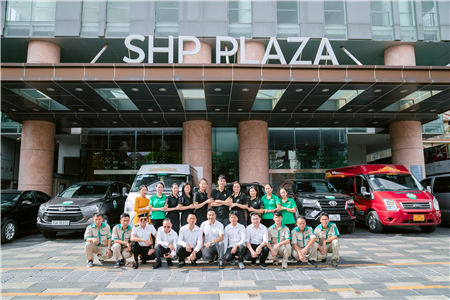For a long time, high-rise apartment buildings have always been considered a symbol of comfort, large, sturdy, and safer from storms than regular houses.
However, before a fierce storm with raging rain and wind that lasted for many hours continuously like Typhoon Yagi, many people living in high-rise apartments had unforgettable experiences of the power of natural disasters, as well as It seems necessary to have better and higher safety solutions soon.
After the storm began to make landfall, many people in high-rise apartments began to feel the threat of gusts of wind that shook the structure of windows and balcony doors. The fierce wind also continuously "howled, howled" through each gap for many hours.
.png)
Next, along with strong winds, there was also the presence of torrential heavy rain. The windows, walls, and balcony doors made of aluminum and glass frames have shown their helplessness in the face of gusts of wind and rain.
Water began to seep in from all the slots even though there were full molds, seams, and rubber gaskets. People had to cope by covering themselves with rags and towels to quickly absorb the water. But when water sprays in large jets through the joints connecting the frame and door frame from all directions, resisting wind and rainwater becomes an impossible task.
During the storm, some apartments had their windows and glass walls blown away by wind and rain, while others had water pouring from the ceiling straight to the floor. Outside on the balcony, the wind whipped around flower beds and ornamental plants.
On the evening of September 7, heavy rain and strong winds caused many people living on high floors to begin to feel the shaking of the building. Many people have shared a "seasick-like" feeling. Extremely strong wind pressure made it impossible to open all doors, resulting in all plans to relocate immediately being extinguished.
The situation became even more difficult when many apartment complexes had to cut off electricity and elevators.
In the basement parking lot, water poured in from every corner, threatening the valuable assets here. In the ground floor lobby, wind and rain tore down the ceiling and shattered glass windows. In the internal campus between high-rise buildings, in many places the water rose to a height of 60 - 70cm, many large and small trees collapsed and were uprooted.
The reality that I noted above from my own experience, that of my friends and on social networks is a warning about the need to soon synchronously complete regulations to ensure safety for high-rise apartment buildings, in order to Responding effectively to major storms may become very complicated in the future.
Known as the modern house type of the new era with large height and volume, complex shape organization with many angles, dense population. When there is strong stormy weather, the impacts on the building structure are very complicated due to the combination of many objective factors such as: impact of wind gust load, impact of rain and flooding, of construction shaking...
And there are also subjective reasons such as: Lack of effective response procedures, panic and poor ability of residents to escape on their own.
Therefore, if an incident occurs during a natural disaster or storm, the loss of life and property will certainly be huge. In many countries around the world, the development of safety regulations and procedures to effectively respond to emergencies for high-rise buildings has been researched very early. In particular, clearly state the safety regulations right from the stage of location planning, architectural design, spatial organization of apartments, to relocation and escape procedures, operation and maintenance of facilities. rescue space/equipment with a very high level of detail.
Experimenting with resistance to heavy rain and strong winds with realistic simulation is required for high-rise buildings in unfavorable locations in urban areas, in order to consider wind load pressure and wind locations. shock, vibration and vibration of the building in windy and stormy conditions...
In Vietnam, although the Construction industry has early researched and promulgated legal regulations on architecture and structure to ensure safety and effective amenities for high-rise apartments, effectively contributing to the development of construction projects. Synchronously developing the high-rise apartment building system in all provinces and cities in recent times.
However, with the increasingly complicated developments of climate change and the possibility of facing fierce storms like Yagi that will still occur, in my opinion we need to soon innovate and upgrade the system of standards. , design standards to ensure safety against storms for high-rise apartment buildings based on the main criteria: "Remote prevention, effective response".
In particular, it is necessary to clearly stipulate detailed requirements for effective drainage when local flooding occurs in heavy storms, safety in the design of the cover, airtightness, and watertightness. sustainable... avoid overuse of glass on facades.
The load-bearing structure of the building must ensure resistance to vibrations and vibrations, eliminating resonance effects such as wind, rain, and flooding. The spatial organization design ensures that pressure does not press on the main doors, ensures the ability to relocate and escape in case of an incident, and at the same time upgrade the existing multi-purpose community room in apartment buildings into a safe place to escape. Avoid storms safely and effectively on the spot.
We need to limit the use of facade covering materials and structures, especially window components, walls, and balcony doors with metal frames and glass that do not ensure quality.
Authorities must check the production, construction and installation process of window components, walls, and metal frame balconies, because this is the most vulnerable and vulnerable place on the facade of the common project. high-rise buildings during storms. Accordingly, focus on checking steps such as: injecting glue when assembling metal door and wall joints, installing rubber bands and seams for the door, injecting foam glue into the gaps between the wall and door frame... This is often done carelessly or even ignored, greatly affecting the ability of each apartment and the entire building to withstand storms.
Finally, a specific guidance process on organizing on-site rescue teams capable of immediately and effectively handling the procedures for cutting or turning on household electricity, opening or closing the elevator system, and moving furniture. outside the balcony and forced relocation of people at each specific level is what needs to be done.


















